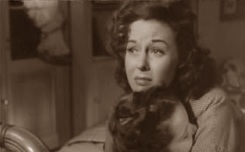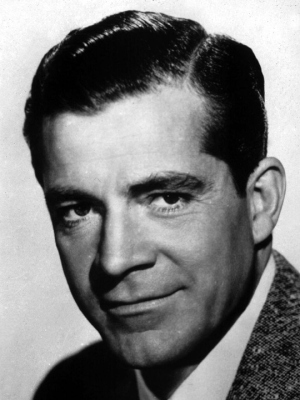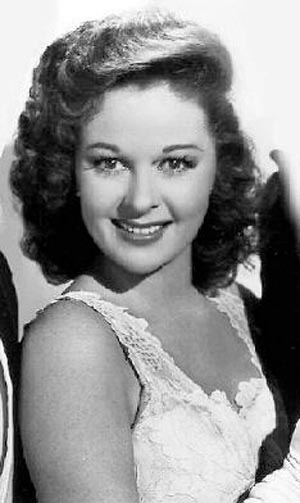




My Foolish Heart (1950)
| Production Company: | The Samuel Goldwyn Company |
| Director: | Mark Robson |
| Writers: | J. D. Salinger (Original Story) |
| Julius J. Epstein | |
| Philip G. Epstein | |
| Cast: | Dana Andrws (Walt Dreiser) |
| Susan Hayward (Eloise Winters) | |
| Kent Smith (Lewis Wengler) | |
| Lois Wheeler (Mary Jane) | |
| Jessie Royce Landis (Martha Winters) | |
| Robert Keith (Henry Winters) | |
| Gigi Perreau (Ramona) | |
| Karin Booth (Miriam Ball) |
This movie was very popular at the time of its release and still holds up well today, but its author absolutely detested it. My Foolish Heart is the only movie ever based on a J.D. Salinger story. The writer was so incensed at Hollywood's treatment of his story, "Uncle Wiggly in Connecticut," that he refused to sell the rights to any more of his stories to the movies. Indeed, his last will and testament has a stipulation blocking any Hollywood adaptations of his works even after his death.
 CARVER DANA ANDREWS was born in Mississippi in 1909. He was the son of a
Baptist minister, among the oldest in a brood of 13 children (one of his younger
siblings is actor Steve Forrest). Andrews studied Business Administration at Sam
Houston State Teacher's College and took a bookkeeping job with Gulf Oil in 1929.
In 1931, he hitchhiked to California with hopes of becoming an actor. His employer
at a Van Nuys gas station believed in him and agreed to invest in him, asking to
be repaid when and if Andrews succeeded with acting. Andrews had a fine singing
voice and studied opera as well as entering the prestigious Pasadena Community Playhouse.
He became a company favourite there, and appeared in dozens of productions. This
led to a contract with Samuel Goldwyn in the late 1930s, and work at Twentieth Century-Fox
(after Goldwyn sold 50% of Andrews' contract to Fox). He hit his stride in the mid-1940s
with such hits as The Ox-Bow Incident (1943), Laura (1944) and The
Best Years of Our Lives (1947).
CARVER DANA ANDREWS was born in Mississippi in 1909. He was the son of a
Baptist minister, among the oldest in a brood of 13 children (one of his younger
siblings is actor Steve Forrest). Andrews studied Business Administration at Sam
Houston State Teacher's College and took a bookkeeping job with Gulf Oil in 1929.
In 1931, he hitchhiked to California with hopes of becoming an actor. His employer
at a Van Nuys gas station believed in him and agreed to invest in him, asking to
be repaid when and if Andrews succeeded with acting. Andrews had a fine singing
voice and studied opera as well as entering the prestigious Pasadena Community Playhouse.
He became a company favourite there, and appeared in dozens of productions. This
led to a contract with Samuel Goldwyn in the late 1930s, and work at Twentieth Century-Fox
(after Goldwyn sold 50% of Andrews' contract to Fox). He hit his stride in the mid-1940s
with such hits as The Ox-Bow Incident (1943), Laura (1944) and The
Best Years of Our Lives (1947).
At the height of his popularity in the late 1940s, a studio publicist for Fox sent a telegram to the town of Collins, Mississippi, suggesting the town might want to change its name to Andrews in honour of its native son. The mayor wired back: "We will not change our name to Andrews. Have Andrews change his to Collins."
None of his subsequent films lived up to the promise of those early hits. Throughout the 1950s, Andrews turned in sturdy performances in a steady stream of unremarkable films. He became an alcoholic, leading some wary producers to look elsewhere for a leading man. After several years, Andrews tackled the alcoholism and regained control of his life. He became a member of the National Council on Alcoholism and spoke out against the public's refusal to face the problem. He also served as president of the Screen Actor's Guild from 1963 to 1965. Then he retired from films entirely to work in the much more lucrative business of L.A. real estate.
Though Andrews was a strong singer, he was rarely given a chance to sing in a movie. In the one musical he did make, 1945's State Fair, his voice was dubbed because the studio was unaware he could sing. He later explained he didn't correct the mistake because he figured the singer doing the dubbing probably needed the money.
Andrews had been left a widower with one child when his wife, Janet Murray, died in 1935. He married actress Mary Todd in 1939 and they remained together for the rest of his life; the couple had three more children. He suffered from Alzheimer's disease late in life and had to move to a nursing home. In 1990, his long-time friend Burt Lancaster was there visiting Andrews when Lancaster suffered the severe stroke from which he never recovered. Dana Andrews died of congestive heart failure and pneumonia in 1992.
 SUSAN HAYWARD was born Edythe Marrenner in Brooklyn, in 1917, of Irish and
Swedish parents. Her father was a transportation worker, and the family lived fairly
comfortably, though in later interviews she often depicted them as poverty-stricken.
Edythe was the third and youngest child and grew up in the shadow of her mother's
favourite, her older sister Florence. Hayward nursed a lifelong grudge against her
mother's perceived neglect, and her determination to outshine her sister gave her
a single-minded drive that later served her well in the movie business. She studied
to be a secretary, but broke into show business as a model instead. She went to
Hollywood in 1937 in hopes of being discovered to play Scarlett O'Hara. Since Edythe
was a beautiful redhead, her management decided to capitalize on the popularity
of another movie redhead; the name 'Susan Hayward' was decided upon by her management
to be "as close to Rita Hayworth as we can get away with."
SUSAN HAYWARD was born Edythe Marrenner in Brooklyn, in 1917, of Irish and
Swedish parents. Her father was a transportation worker, and the family lived fairly
comfortably, though in later interviews she often depicted them as poverty-stricken.
Edythe was the third and youngest child and grew up in the shadow of her mother's
favourite, her older sister Florence. Hayward nursed a lifelong grudge against her
mother's perceived neglect, and her determination to outshine her sister gave her
a single-minded drive that later served her well in the movie business. She studied
to be a secretary, but broke into show business as a model instead. She went to
Hollywood in 1937 in hopes of being discovered to play Scarlett O'Hara. Since Edythe
was a beautiful redhead, her management decided to capitalize on the popularity
of another movie redhead; the name 'Susan Hayward' was decided upon by her management
to be "as close to Rita Hayworth as we can get away with."
Though she didn't win the role of Scarlett, Hayward found lots of other work. Small parts soon became leading roles, as her talent and intense focus led to success. After the war, she became one of Hollywood's favourite leading ladies, and she racked up five Academy Award nominations. My Foolish Heart was one of the films for which she was nominated, and its success went a long way toward earning her better film roles. She finally won the Academy Award as Best Actress for I Want to Live! in 1958.
Some of her personality traits were a poor fit in Hollywood. Directors enjoyed her professionalism, but she was not chummy when the cameras stopped. Many co-workers described her as icy, cold and aloof. She disliked crowds and effeminate men. Unlike most female stars, she was a sports fishing enthusiast and owned several ocean-going boats. Both of the men she married were rugged, outdoorsy Southerners.
She was first married to Jess Barker. Their marriage - frequently described in the press as "turbulent" - lasted ten years and produced twin sons before they divorced in 1954. Her second marriage, to a Georgia rancher and businessman, lasted happily until his death in 1966. She became a recluse and seldom worked after he died.
Susan Hayward had been one of the many cast and crew members of the 1956 film The Conqueror, which was shot in the Utah desert amid heavy nuclear testing. The link between exposure to nuclear fallout and cancer was little understood at the time, but Dr. Robert Pendleton of the University of Utah has since described the incidence of cancer among those who worked on The Conqueror as "an epidemic." Director Dick Powell, Hayward, Agnes Moorhead, John Wayne and Pedro Armendariz were among over 90 cast and crew members who later developed untimely cancers. In 1975, despite being very ill with brain cancer, Hayward insisted on a final hurrah: after many hours in the makeup chair, and drawing heavily upon her formidable willpower, Hayward made her final appearance as a presenter at the 1975 Academy Awards. She died soon after, aged only 57.
Notes by Paddy Benham